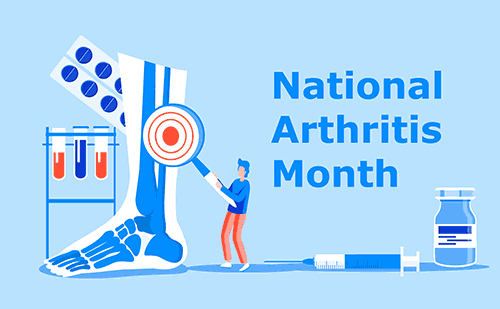
National Cleft and Craniofacial Awareness & Prevention Month
Mid-Month HC & GN Updates from Nurse Sherri July marks National Cleft and Craniofacial Awareness and Prevention Month. Children with cleft lip, palate, or other

Hello May! Springtime feels official and it’s time to break free and explore the great outdoors. Many of us can’t run trails, and sometimes walking is hard for the 53 million adults in America with arthritis. , and there’s a reason it is our #1 cause of disability, creating 172 million missed workdays every year. And it’s not just a disease of aging, as 300,000+ babies, kids, and teens have arthritis or rheumatic conditions. Arthritis runs together with other conditions as many also develop heart disease, high blood pressure, diabetes, obesity, anxiety, and depression. One reason arthritis is so dangerous is that it stops us from moving comfortably and being sedentary is downright hazardous.
Osteoarthritis (OA) is known as degenerative joint disease and occurs when the cartilage degrades between the bones or joints creating that ‘bone on bone’ feeling of misery. It is linked to aging or injury and presents with pain, swelling, and limited motion as the cartilage loss changes the formation of the bone. Psoriatic arthritis (PA) often accompanies psoriasis as an autoimmune condition where painful, reddened joints swell and itch, moving around the body. Rheumatoid arthritis (RA) is when the body’s immune system attacks the synovium in the joints, thickening the fluid, restricting movement, and creating painful reddened joints. Inflammation is the root cause of all 3, and each can affect the hands, feet, elbows, knees, back, and shoulders. There is no cure, and symptom management and lifestyle are key.
Common treatments are analgesics like Tylenol and opiates, and NSAIDs like Motrin and Alleve. All can help with pain, but don’t treat the inflammation causing the issues. Topical treatments like capsaicin cream can distort the signals coming from the area to lessen the pain. Steroids like Prednisone help temporarily to reduce pain and inflammation but can’t be taken long term because they suppress the immune system and risk infection to the patient. The antidepressant Cymbalta and seizure drug Lyrica also help by changing perceptions of nerves and emotions. All can help temporarily, but the goal is to manage the long term with the least amount of RX.
The key to arthritis care is great self-care! Nutrition is your first ally, and the anti-inflammatory diet will quiet many of the triggers. Exercise is the next key – though it sounds counterintuitive to move when it hurts, it is the path to fighting stiffness and pain. Strengthening can alternate with stretching, balance, and range of motion exercises. Diet and exercise are the treatments that keep the weight off as well – less weight means less pressure on stressed joints. Holistic care with chiropractic and acupuncture works for many and several therapists should be tried before you find the right techniques for you. Many still opt for joint replacements (knees, hips) and today it can be easy to click, schedule, and recover. And insurance might pay for it!
Cannabinoids fill the gaps in all the above, and for those who prefer natural, are a preferred treatment. Cannabinoid receptors are prolific throughout the brain and all physiologies, and the ECS (endocannabinoid system) is constantly sensing distress and making adjustments. But if it is deficient then wouldn’t it make sense to supplement that? CBD & THC and other phytocannabinoids activate the ECS to nourish it first, kickstarting the body’s healing ability. CBD is anti-inflammatory, and systemic ingestion as a daily nutrient may reduce the pro-inflammatory cytokines and other irritants to the joints. THC can suppress the immune system, but it also modulates, meaning it can balance it whichever way is towards health.
The best part of plant medicine is the lack of side effects! Dizziness, fatigue, appetite, and some perceptual changes are manageable with dosing and adjustments. Having cannabinoids as part of the treatment plan can help reduce other RX, making dosing safer. Small doses of CBD and other cannabinoids can be taken without interactions but check with a nurse if you have several medications. Cannabis is ‘pleiotropic’, working to aid pain, soreness, anxiety, promote relaxation, deepen sleep, and lift energy – all with one botanical. Because phytonutrients activate the ECS, this umbrella of healing can unfold. The key is knowing what to take, and how.
At Holistic Caring & The Green Nurse, we start by determining your goals, reviewing your symptoms and medications, and educating you on how these products work to restore balance.
Our trained nurses will help you create and refine a plan to address your symptoms, reducing the time and costs of trial and error. With our targeted online learning programs, you can quickly become confident in how to be a smart shopper, how to safely stack beneficial products, and how to fine-tune your body with just the right approach.
This month take 25% off our Patient Pathway on Managing Chronic Pain with Cannabis: PAIN25
Bloom Hemp offers free shipping with the code: GREENNURSE

Mid-Month HC & GN Updates from Nurse Sherri July marks National Cleft and Craniofacial Awareness and Prevention Month. Children with cleft lip, palate, or other

Many individuals have expressed the opinion that there is a notable lack of research in the field of cannabis therapeutics, and we are inclined to

Let’s honor the past and continue advocating for a better future. The movement for medical cannabis, an instrumental part of modern healthcare, has a
Holistic Caring® is an umbrella of progressive health professionals who provide products & services to support and nourish the endocannabinoid system.
We serve the plant, the people and the planet for hope and inspiration for growth and healing to the patients we serve and the practitioners we work with.
We provide Educational Programs & Nurse Coaching Services.
Contact
© 2024 All rights reserved – Content Agreement – Privacy Policy – Terms – Accessibility Statement–Returns/Shipping/Cancellation
